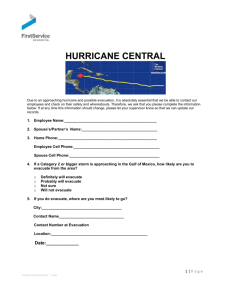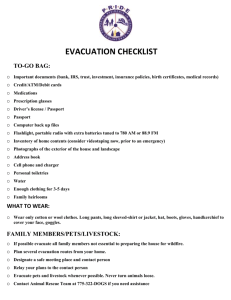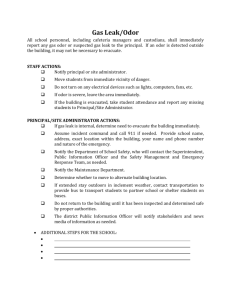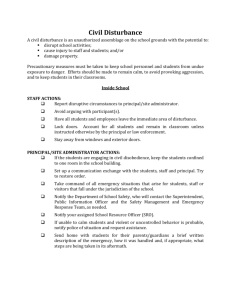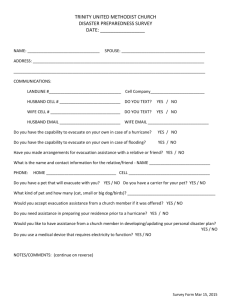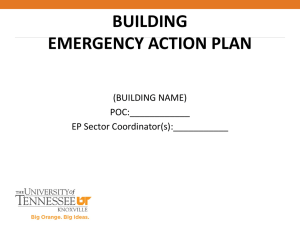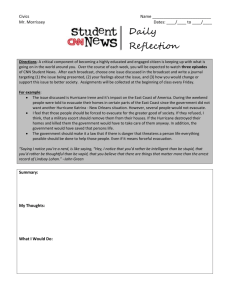EMERGENCY REF GUIDE__Final
advertisement
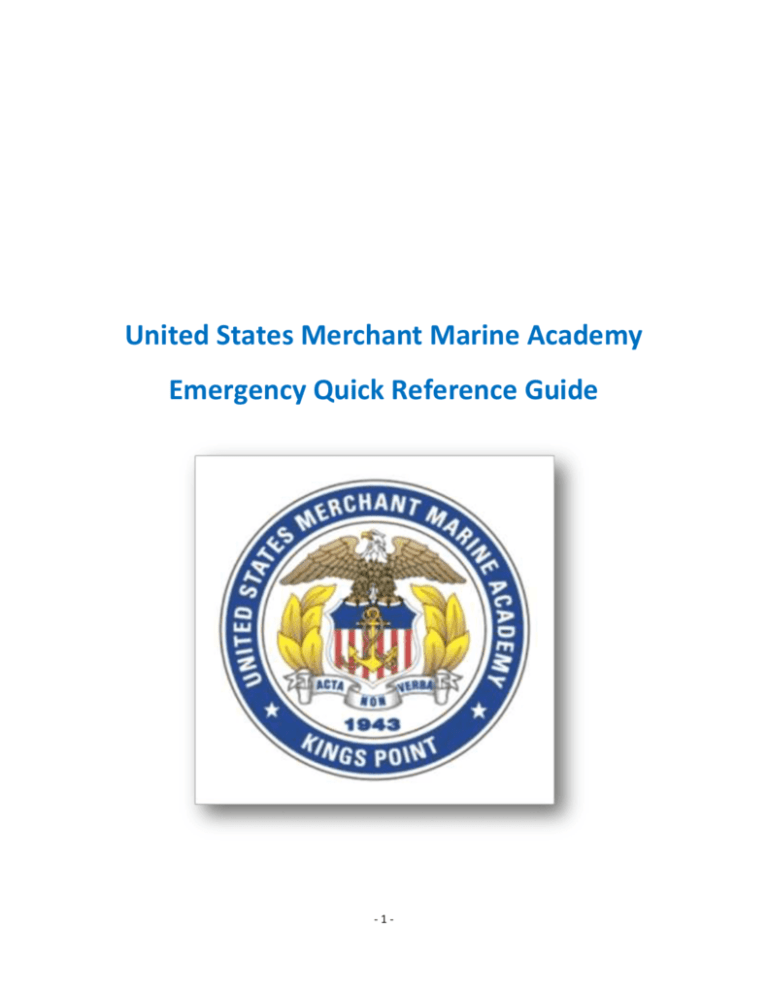
United States Merchant Marine Academy Emergency Quick Reference Guide -1- Purpose of this Guide The Academy has always worked towards ensuring the campus is a safe place to learn and work. Midshipmen, faculty, and staff can help the Academy safeguard the campus by taking preventative measures to ensure safety and preparedness, and by referencing this guide in the event of an emergency. While we cannot provide information on all possible incidents that may occur, the information provided in this guide will give you basic procedures to follow in the event of a number of different emergencies. This guide can serve as a quick reference for what to do and who to notify for many different types of emergencies. This is not a comprehensive list of instructions and resources, rather a reminder of the basic steps that should be taken to minimize risks associated with a given hazard and to protect yourself and others from harm. Time is the most important factor in the optimal management of these types of situations. -2- EMERGENCY PHONE NUMBERS AND OTHER RESOURCES Note: If dialing from USMMA telephones, use only the last four digits. Blue Light Phones There are 6 Blue Light Phones located on the Academy grounds: 1) outside Wiley Hall, (2) by the Museum, (3) on the Waterfront by the Chapel, (4) by Brooks Field House, (5) on Farrel Road, and (6) on Tombs Memorial Field. The Blue Light Phones may be used in the event of any type of emergency. If you press the emergency button, you will be connected to the Public Safety Command Center. Emergency Numbers USMMA EMS Ambulance (Medical Emergency): *516.726.5858 or X5858 USMMA Public Safety (for Police & Fire): 516.726.5911 or X5911 Sexual Assault USMMA 24/7 Sexual Assault Hotline: 516.462.3207 Nassau County Safe Center 24/7 Hotline: 516.542.0404 * Note 1: When you dial 516.726.5858 or X 5858, the call goes to the Vigilant Fire Company dispatcher. They may answer, “Firehouse” or “Fire Department”. **Note 2: All cellphones in the lock mode have the capability to dial 911. USMMA Office Numbers Office of Health Services (Patten Counseling): 516.726.5680 (Option #4) Office of Health Services (Patten Medical): 516.726.5680 (Option #3) Sexual Assault and Response Coordinator (SARC): 516.726.6153 Command Chaplain: 516.726.5907 Public Safety Office: 516.726.5848 After Normal Business Hours – Non-Emergency Issues Public Safety Command Center: 516.726.5847 (available 24 hours, 7 days per week) -3- ACTIVE SHOOTER/HOSTILE INSTRUDER PROCEDURES TO FOLLOW Immediately notify 911 and Public Safety (516.726.5911) only when it is safe to do so. If you hear or see a person with a weapon, immediately remove yourself from the area. If there is no safe escape route from the building, find a room or space for safe shelter and lock and/or barricade yourself in. Close and lock all window and doors, close blinds or curtains, barricade the door if possible, and turn off the lights and all audio equipment. Remain quiet and do not open the door for anyone. Silence your phone, including vibrate mode. Do not stay in open hallways. If safe to do so quietly, notify a personal contact and advise of your location. Do not sound a fire alarm. A fire alarm would signal occupants of the building to evacuate and potentially send them into harm’s way. Try to stay calm and be as quiet as possible. If left with no other choice or if you feel you can get out of a building safely by running, then do so but do not run in a straight line. Run in a zig-zag fashion and keep an objects you can find in between you and the hostile intruder. When outside, use trees, bushes and cars as cover to block you. Summon help anyway you can and warn others. If the person(s) is causing death or serious physical injury to others and you are unable to run or hide, you may choose to act like you are dead if other victims are around you. The last option you may have if caught in an open area is to fight back. This is dangerous, but depending on your situation, this could be your only option. If you are caught by the intruder and are not going to fight back, obey all commands and do not look the intruder in the eyes. When police arrive, they will not know who the shooter is. Officers will move quickly and directly. Keep your hands empty and in plain view at all times for police officers and follow all directions and commands. Early in an incident, officers may not be able to rescue people, because the main goal is to neutralize the shooter(s). Involved persons need to remain calm and not interfere with police operations. PUBLIC SAFETY EMERGENCY: 516.726.5911 -4- BOMB THREAT PROCEDURES TO FOLLOW BOMB THREAT PHONE CALL If you receive a threatening call (bomb, physical harm, etc.), do no hang up or transfer the call; try to signal someone else to call Public Safety from another extension or telephone, if possible. Every attempt should be made to engage the caller in a conversation and obtain as much information as possible. As a matter of good practice, it is recommended that a copy of the USMMA Bomb Threat Checklist be kept by your phone at all times. If possible, place the USMMA Bomb Threat Checklist in front of you and refer to it when speaking with the caller. Take notes throughout the phone call. Try to signal someone else while you are on the phone (email/note/text) of the situation and have them call Public Safety immediately. If your phone has caller ID, write down the number immediately and try to convey this to law enforcement or Public Safety. Keep the caller on the line as long as possible. Ask him/her to repeat the message. Record every word spoken by the caller. If the caller does not indicate the location of the bomb or the location of the possible detonation, ask for this information. Inform the caller that the building is occupied and the detonation of a bomb could result in death or serious injury to many innocent people. Pay particular attention to background noise, such as music playing, motors running and any other noise that may provide valuable information in identifying the location of the caller. Listen closely to the caller’s voice for accents, speech impediments, gender or any other characteristics that could be helpful in identifying the caller. After the caller hangs up, personally call Public Safety to brief them of your phone call. Bomb Threat via Email: Immediately notify Public Safety at 516.726.5911 (X5911). Forward email threat to the Public Safety (DeJesusp@usmma.edu) Office AND NEVER DELETE THE EMAIL. Bomb Threat via Mail: -5- Immediately notify Public Safety at 516.726.5911 (X5911). EVACUATION: The decision to evacuate will be made by the Academy and local official authorities, based on an assessment of the information and circumstances surrounding the threat. If the decision to evacuate has been made and specific instructions for evacuation are issued, try to remain calm and avoid panic. Walk to the nearest exit. DO NOT use cell phones, radios or other electronic devices within 300 feet of the area suspected of containing the explosive device. If possible, warn others to evacuate. Check for, but DO NOT disturb, unusual objects as you evacuate. Report your observations to the emergency personnel. Evacuate 200+ yards from the area of the threat. PUBLIC SAFETY EMERGENCY: 516-726-5911 OR X5911 -6- CARBON MONOXIDE PROCEDURES TO FOLLOW: Carbon monoxide (CO) cannot be seen or smelled. If you are in a building with a CO alarm, you should do the following when an alarm sounds: Open all windows and doors. Leave the building immediately and go outside to fresh air. If it is safe to do so, assist others who need assistance. Call Public Safety as soon as possible at 516.726.5911. Advise others not to enter the building. *In the event you do not have a CO detector or if the CO detector is malfunctioning, the following symptoms could be a sign of CO poisoning: headache, nausea, fatigue, confusion, convulsions, elevated heart rate and drowsiness. If people around you are unconscious, you should seek emergency help immediately. It is important to note that it is possible to have no symptoms when exposed to dangerous levels of CO or to mistake symptoms for the flu. PUBLIC SAFETY: 516.726.5911 (X5911) -7- EARTHQUAKE PROCEDURES TO FOLLOW: If the ground or a building that you are in begins to shake: If you are outdoors: Stay outdoors. Do not attempt to enter a building. Move away from trees, poles, and buildings. If you are indoors: Stand in a doorway or get underneath a sturdy piece of furniture (table or desk). Stay away from windows, hanging fixtures, or furniture that may topple or fall off the wall. Hold on to the doorway or the leg of a desk or table and use your arms to protect your face, head, and neck. Stay where you are until the shaking stops. Be aware that the power may go out and that fire alarms or sprinkler systems may activate. After the shaking stops, evacuate the building. DO NOT use elevators. Assist others in need of assistance. If someone is unable to evacuate they should wait by the nearest stairwell and telephone Public Safety of their whereabouts. If possible, hang a garment/sign out the window to let first responders know there is someone who needs help evacuating. Notify first responders of locations of individuals unable to evacuate. Provide care to injured individuals. Only call Public Safety or 911 if a life threatening situation exists. DO NOT re-enter the building until you are told by responders that it is safe for re-entry. If you are trapped by debris: Do not light a match or use any source of flame. Remain as still as possible to avoid kicking up dust. Cover your mouth with clothing, if possible. Tap on a pipe or wall so that rescuers can locate you. Shout only as a last resort. Shouting can cause you to inhale dangerous amounts of dust. Public Safety: 516.726.5911 (X5911) -8- EVACUATION PROCEDURES PROCEDURES TO FOLLOW In an emergency, dial 516.726.5911 (X5911). If the fire alarm sounds or you are notified by an official, evacuate by using the nearest safe exit. Assist others, including persons with disabilities, if safe to do so. Notify emergency personnel of the location of people who are still in the building or not accounted for. Do not return to the building or move to another location unless told to do so by officials. Physically challenged persons unable to exit from upper or lower floors should wait in a stairwell and notify Public Safety by phone of their location (516.726.5911 or X5911). DO NOT use elevators! Once outside, proceed to a clear area that is at least 200+ yards away from the affected building. Keep streets, fire lanes, hydrant areas and walkways clear for emergency vehicles and personnel. DO NOT return to an evacuated building unless told to do so by an Academy official or official authorities. -9- FIRE, EXPLOSIONS, AND SMOKE CONDITIONS PROCEDURES TO FOLLOW In an emergency dial 516.726.5911 (X5911), activate the buildings nearest red fire alarm pull box, or use an outdoor Blue Light Phone. If you smell smoke or see any evidence of smoke or fire, or the fire alarm activates in your building: Immediately evacuate the building. DO NOT use elevators! Close all doors and windows behind you as you evacuate. DO NOT LOCK DOORS OR WINDOWS. It is important to close windows and doors in case you need to retreat back to this area BUT only if it is safe to do so. If an alarm is not already sounding, immediately activate the nearest fire alarm pull station. If you cannot find a fire alarm, knock on the doors and yell “FIRE” as you evacuate. DO NOT FIGHT THE FIRE, PROCEED TO EVACUATE AND INFORM OTHERS TO DO SO. Feel closed doors with the back of your hand before opening. IF A DOOR IS HOT, DO NOT OPEN IT. When you evacuate, stay 200+ feet away from the fire and clear the way for the emergency responders. As soon as you evacuate, call 911 and 516-726-5911 to alert emergency personnel of the size and location of the fire. If someone is unable to evacuate, tell them to wait by the nearest stairwell as close to the floor as possible. Always advise emergency personnel if you know that someone is in the building. DO NOT re-enter the building that is on fire or subject to other hazardous conditions. In the event you become trapped in a building during a fire and a window is available, place an article of clothing outside the window as a marker for rescue crews. If there is no window, stay near the floor where the air is less toxic. Close all doors and windows. Wet and place cloth material around and under the door to prevent smoke from entering. Attempt to signal people outside the building. If you can, call Public Safety at 516-726-5911 to let them know where you are. Shout at regular intervals to alert emergency crews of your location. DO NOT PANIC. NOTE: Academy policy requires all individuals to immediately evacuate the building when a fire alarm sounds. Immediately proceed to the nearest and safest exit. - 10 - GAS LEAK/FUMES PROCEDURES TO FOLLOW: GAS LEAK/FUMES: If you suspect a gas leak or detect the scent of natural gas (smells like sulfur or rotting eggs): Immediately clear the area and leave the building. Do not use elevators. DO NOT turn anything on, make a phone call with a cellular phone, smoke cigarettes, light matches or candles, or do anything that might create heat or a spark. DO NOT use your cell phone until you leave the area of the suspected leak. Open windows if you can. Contact Public Safety immediately. Be prepared to provide your location and the location of the odor and as many details as possible. Do not attempt to turn off the gas on your own. Help others who need assistance. Stay away from the building until you are told by responders that it is safe for re- entry. .*SEE TOXIC ODORS AND HAZARDOUS MATERIALS. PUBLIC SAFETY: 516.726.5911 (X5911) DEPARTMENT OF PUBLIC WORKS: 516.726.5909 (X5909) PUBLIC SAFETY COMMAND CENTER: 516.726.5847 (X5847) - 11 - HAZARDOUS CONDITIONS PROCEDURES TO FOLLOW Spilled liquids and wet floors are one of the major causes of slips, trips and falls. If you spill something, please have it cleaned up immediately. If you discover a spill or wet floor and need assistance, please contact the Regimental Logistics Officer (Corporate Source Contract) at 516.726.6155 (X6155). Report all other trip and fall hazards (malfunctioning elevators, holes in the sidewalk, loose carpet, etc.) to the Regimental Logistics Officer immediately. Regimental Logistics Officer: 516.726.6155 (During Normal Business Hours) Public Safety Command Center: 516.726.5847 (After Normal Business Hours) - 12 - HAZARDOUS MATERIALS Hazardous materials are defined as any substance that causes or may cause adverse effects on health or safety of individuals, the general public, or the environment. Do not risk exposing yourself to the hazardous material. Do not attempt to clean up a spill or release unless you are trained and have the proper equipment. PROCEDURES TO FOLLOW Call Public Safety to report the spill. Notify others in your area that a spill has occurred. Evacuate the room, floor or building, as necessary. Do not hesitate to pull the fire alarm, if necessary, to evacuate the building. For flammable materials, turn off all ignition sources. Close doors and windows to the area where the spill occurred. Limit access to the area. Stand by the area outside the building until help arrives. Report the spill to your supervisor and to the Senior Safety Officer (726-5894). If the exposure is outdoors, you may be instructed to go indoors and Shelter-in-Place. See Shelter-in-Place section for further instruction. Provide the following when reporting spills: Personal injuries, if any. The location of the spill (building and room number). The name of material(s) involved (spell clearly and slowly), if known. The amount of material spilled. Immediate actions taken. How spill occurred (if known or suspected). Who first noticed the spill and at what time. Call back telephone numbers. Department of Public Works: 516.726.5909 (X5909) (During Normal Business Hours) Safety Environmental: 526.726. 5893 (X5893) Command Center: 516.726.5847 (After Normal Business Hours) - 13 - HOW TO REPORT A CRIME PROCEDURES TO FOLLOW Notify Public Safety immediately if you believe a crime has occurred. Be prepared to describe the situation, suspect or stolen item. Do not approach a suspect. Instead, observe the following and, when it is safe, notify Public Safety: 1. 2. 3. 4. 5. 6. 7. 8. Description of the suspect. Take note of unique features (Example: Tattoos, scars, etc.). Vehicle type. Plate number. Race. Age. Gender. Appearance. Location. Public Safety: 516.726.5911 (X5911) - 14 - LOCKDOWN Lockdown procedures are appropriate for threats posed from outside or inside the building. These threats could include a violent person attempting to enter the campus or campus buildings, a perpetrator already inside, an active shooter situation or nearby criminal or terrorist activities. When lockdown is in effect, no one will be able to enter or leave the campus. PROCEDURES TO FOLLOW Stay out of line of sight of windows and doors. Close and lock doors and windows (if it is safe to do so). If it is safe to do so, barricade doors. Cover doors and windows (close blinds). Turn off room or office lights and remain quiet. If you have a cell phone, silence it completely (this means no vibrate mode). Faculty, Staff and Midshipmen who are outside must move quickly to a safe space/room and follow these lockdown procedures. Stay in lockdown until emergency personnel notify you that it is safe to leave. If it is safe to do so, notify others of the need to go into lockdown. - 15 - MEDICAL EMERGENCIES PROCEDURES TO FOLLOW If you believe that someone is experiencing a medical emergency on campus, dial 516.726.5858 (X5858) to get help immediately. In addition, notify Public Safety of the medical emergency by dialing 516.726.5911 (X5911). Be prepared to provide specific information about your location and the nature of the emergency. ASSIST THE VICTIM These measures do not require training and cannot harm a person. Provide care following these instructions if it is safe and you are comfortable doing so. Heart Attack/Cardiac Arrest If the person is unconscious and there is no pulse detected, attempt to wake them up by shaking them and speaking loudly to them. If the person cannot be woken, provide Hands-Only CPR by placing your hands in the center of the person’s chest and compressing hard and fast. Do not be afraid, your actions can only help. Do not stop until the person regains consciousness or help arrives. If there is an Automatic External Defibrillator (AED) present, open the AED and follow the AED’s audible instructions. Seizure - If a person appears to be having a seizure, do not restrain them or place anything in or near their mouth. Move objects away from them to prevent injury and attempt to protect their head. Protect the Airway - If the person is vomiting or has fluid in their mouth, roll them onto their side to clear their airway. Control Bleeding - If the person is bleeding, apply direct pressure to the bleeding and do not stop until help arrives. Protect the Spine - If the person fell or hit their head, do not move them or allow them to move unless they are in immediate danger. Keep the Victim Comfortable - Keep the person comfortable and safe and do not allow them to take anything by mouth until responders arrive. EMS/Ambulance: 516.726.5858 (X5858) Public Safety 516.726.5911 - 16 - MENTAL HEALTH EMERGENCY PROCEDURES TO FOLLOW Typically, a mental health emergency occurs when a person is agitated and represents either a threat to him/herself or a threat to others (e.g., either statement threatening self or others or because of uncontrolled behavior). If you feel your safety is threatened for any reason, act to ensure your safety (which may include leaving the scene) and contact public safety at 516.726.5911 (X5911). If you can safely do so, limit the person’s access to potential weapons. If the person might represent an immediate danger to themselves or others, contact Public Safety at 516.726.5911 (X5911) and the Office of Health Services at 516.726.5858 (X5858). If the person has sustained injury, provide medical care, if it is safe for you to do so. As always, an early intervention is best because it can avert more serious situations. If you believe that a mental health situation is urgent (but not an emergency) contact the Office of Health Services as follows: During Normal Business Hours – Monday through Friday from 0730-1630 (except holidays): Midshipmen Counseling at 516.726.5680, Option #4. During Non-Business Hours - the USMMA Emergency Medical Services (EMS) is to be called at 516-726-5858 (X5858). EMS has the ability to communicate with appropriate Office of Health Services personnel or Nassau County Medical Communications MD’s and can arrange for either on site assistance if the situation is non-emergent or transportation to a local emergent intervention resource, depending on which is most appropriate. Public Safety: 516.726.5911 or X5911 Office of Health Services (Patten Counseling): 516.726.5680 (Option #4) - 17 - POWER OUTAGE PROCEDURES TO FOLLOW: If the power goes out in a room or part of a building, contact the Office of Public Works. In the event of a building-wide or after hours outage, or an outage affecting multiple buildings, contact Public Safety. In a Power Outage: If directed to do so, move cautiously to a lighted area. DO NOT light candles or use any other kind of flame for light. This represents a major fire hazard. DO NOT use elevators to evacuate a building during a power outage. Be prepared for multiple power outages. Help those in need of assistance, if possible. Unplug nonessential major electronic equipment (computers, TVs, and etc.) so that they are not damaged when power is restored or in the event of power surges. Department of Public Works: 516.726.5909 (X5909) (During Normal Business Hours) Public Safety Command Center: 516.726.5847 (After Normal Business Hours) - 18 - SEVERE WEATHER EVENTS SEVERE WEATHER PROCEDURES If you see or hear threatening weather or hear that a Severe Weather Warning has been issued for your area: Proceed to Shelter-in-Place. Seek shelter immediately indoors and away from windows. Safe places include interior rooms and hallways on the lowest floors of buildings. Smaller rooms are safer than large rooms. DO NOT go outside until the storm has passed. Close all doors and windows and stay away from exterior doors and windows. In the event of a Tornado, do not remain in a vehicle. Alert others to the oncoming tornado, encourage them to seek shelter and protect themselves from falling and flying debris. Listen to a weather radio or local media reports. DO NOT call Public Safety unless you need emergency assistance. After a storm has passed, survey your area for damage (loose tree limbs, downed utility wires that could be live, and hissing sounds or smells that could be a gas leak). Evacuate the damaged buildings and do not re-enter until the proper authorities declare them safe. In the event emergency personnel is on the scene, follow all directions issued by emergency personnel. To find out the Academy’s operating status during weather events, please call 516-726-5800 (option 3) or go to http://www.usmma.edu/status. Essential employees are required to report to work. Midshipmen will receive guidance from the Commandant. - 19 - SEXUAL ASSAULT PROCEDURES TO FOLLOW: Sexual assault is a crime of violence. Any midshipman or other personnel who has been sexually assaulted or thinks that they may have been sexually assaulted should: Get away from the attacker immediately to a safe place. Report the assault as outlined below. Preserve all evidence. DO NOT wash, comb, or clean any part of your body, and do not change clothes if possible. Protect the crime scene by closing and locking the door where it occurred. Seek medical attention immediately. Even if there are no visible physical injuries, there may be risk of becoming pregnant or acquiring sexually transmitted diseases. Agree to a sexual assault forensic examination to preserve evidence. Whether the assault took place on or off campus, victims are encouraged to report the assault immediately. A midshipman victim of sexual assault has the option to make either a restricted or unrestricted report. Academy staff that are victims of sexual assault should make a report to Civil Rights and/or law enforcement. Restricted Reporting allows the victim to confidentially disclose the details of their assault to specifically identified individuals and receive medical treatment and counseling at a location of the victim’s choice, without triggering the official investigative process. Report the assault to the Academy’s Sexual Assault Response Coordinator (SARC), a Victim Advocate (VA), or an Academy Healthcare Provider (HCP). The assault may also be reported to the Academy’s chaplain. A victim can, at any time after their initial restricted report, pursue unrestricted reporting. Unrestricted Reporting initiates both an official criminal and administrative investigation and allows the victim to receive medical treatment and counselling at a location of their choice. Immediately report the assault to the SARC, law enforcement, through the chain of command, VA, HCP, a midshipman Human Relations Officer, or any trusted advisor, faculty, or staff member. USMMA 24/7 Sexual Assault Hotline (SARC): 516.462.3207 (X3207) USMMA EMS Ambulance: 516.726.5858 (X5858) USMMA Public Safety: 516.726.5911 (X5911) Nassau County Safe Center 24/7 Hotline: 516.542.0404 - 20 - SHELTER-IN-PLACE Shelter-in-Place is appropriate for threats posed by atmospheric contamination and severe weather events. Threats could include accidents or attacks involving chemical, biological or radiological hazards. PROCEDURES TO FOLLOW: In emergencies where the risk is outside (e.g., severe weather, airborne toxin or chemical, violent act), it is important to minimize exposure to the hazard. In circumstances such as these, follow these Shelter-In-Place Procedures. You may determine on your own that it is most safe to shelter in place. If this is the case, do so until you receive instructions to do otherwise, or until it becomes unsafe to shelter in place. You may receive an emergency alert via text message or email instructing you to shelter in place. In these cases: Immediately enter the nearest building if you are not already indoors. Faculty, Staff and Midshipmen members who are in class should remain in their classroom. Close all doors and windows. If necessary, turn out your lights. In the event of air contaminants, turn off air conditioning or heating units where possible, and await further instructions. Stay away from doors and windows. Faculty, Staff, and Supervisors should assist in maintaining order. Remain sheltered indoors until told by Academy officials or emergency personnel that it is safe to go outside. - 21 - SUSPICIOUS PACKAGE PROCEDURES TO FOLLOW: If a package or envelope appears suspicious, DO NOT OPEN IT. Do not touch or disturb the object. NOTIFY PUBLIC SAFETY IMMEDIATELY. Provide the location and a description of the package. Alert others in the area about the suspicious package or envelope. Leave the area, close any doors, and take action to prevent others from entering the area. Notify your supervisor. Wash hands with soap and water to prevent spreading potentially infectious material to face or skin. Seek additional instructions for exposed or potentially exposed persons from the Academy’s Senior Safety Officer. If possible, create a list of persons who were in the room or the area when this suspicious letter or package was recognized and a list of persons who may have also handled this package or letter, and give this list to Public Safety. Be prepared to evacuate. Public Safety Emergency: 516.726.5911 or X5911 Suspicious Package Characteristics Inappropriate or unusual labeling o Excessive postage. o Marked with restrictions, such as “personal,” “confidential,” or “do not x-ray.” o Marked with threatening language. o Postmarked from a city or state that does not match the return address. Appearance o Powdery substance on the package or envelope. o Oily stains, discoloration or odor. o Lopsided or uneven envelopes. o Excessive packaging material such as masking tape, string, etc. Other Suspicious Signs o Excessive weight. o Ticking sound. o Protruding wires or aluminum foil. o Misspellings or an incomplete/inaccurate address. - 22 - THREATENING INDIVIDUAL(S) PROCEDURES TO FOLLOW: A threatening individual is any person who you determine to be a threat to you or those around you. The individual may have a gun or knife or just make you feel uncomfortable. Trust your instincts. Notify Public Safety at 516.726.5911 (X5911) whether the individual poses an immediate threat to you or not. Be realistic about your ability to protect yourself. Stay calm and avoid conflict. If possible, seek protection in a classroom/office that locks and has telephone access. Leave the building immediately if this does not put you at risk with the individual. REMEMBER: Only you can decide which course of action is appropriate during a threatening encounter. Public Safety: 516.726.5911 (X5911) - 23 - TOXIC ODORS PROCEDURES TO FOLLOW: If you notice an unusually strong odor in your building or workspace, please do the following: Remain calm. Do not do anything that could create a spark. Do not turn anything on and do not make a phone call in the area of the odor. When it is safe to do so, notify Public Safety. When it is safe to do so, notify Department of Public Works. Public Safety and Facilities will respond to examine the area. DO NOT TOUCH ANY OBJECT, SPILL OR CHEMICAL THAT IS THE POTENTIAL SOURCE OF THE ODOR. If evacuation is necessary, you will be advised by Public Safety and/or other Academy officials. DO NOT RE-ENTER THE BUILDING UNLESS TOLD TO DO SO BY EMERGENCY PERSONNEL OR ACADEMY OFFICIALS. *SEE GAS LEAK/FUMES. Public Safety: 516.726.5911 (X5911) Department of Public Works: 516.726.5909 or X5909 - 24 - WATER LEAK PROCEDURES TO FOLLOW: Report all water leaks immediately to the Department of Public Works or to Public Safety if the water leak occurs after hours. If it is safe to do so, turn off/unplug all electrical equipment. If hazardous materials are involved, refer to the Hazardous Materials section of this document. If a water leak is due to a storm, relocate to a safer area or alternate location. Use absorbent materials to contain the water and isolate the affected area if it is safe to do so. Department of Public Works: 516.726.5909 (X5909) (During Normal Business Hours) Public Safety Command Center: 516.726.5847 (After Normal Business Hours) - 25 -
